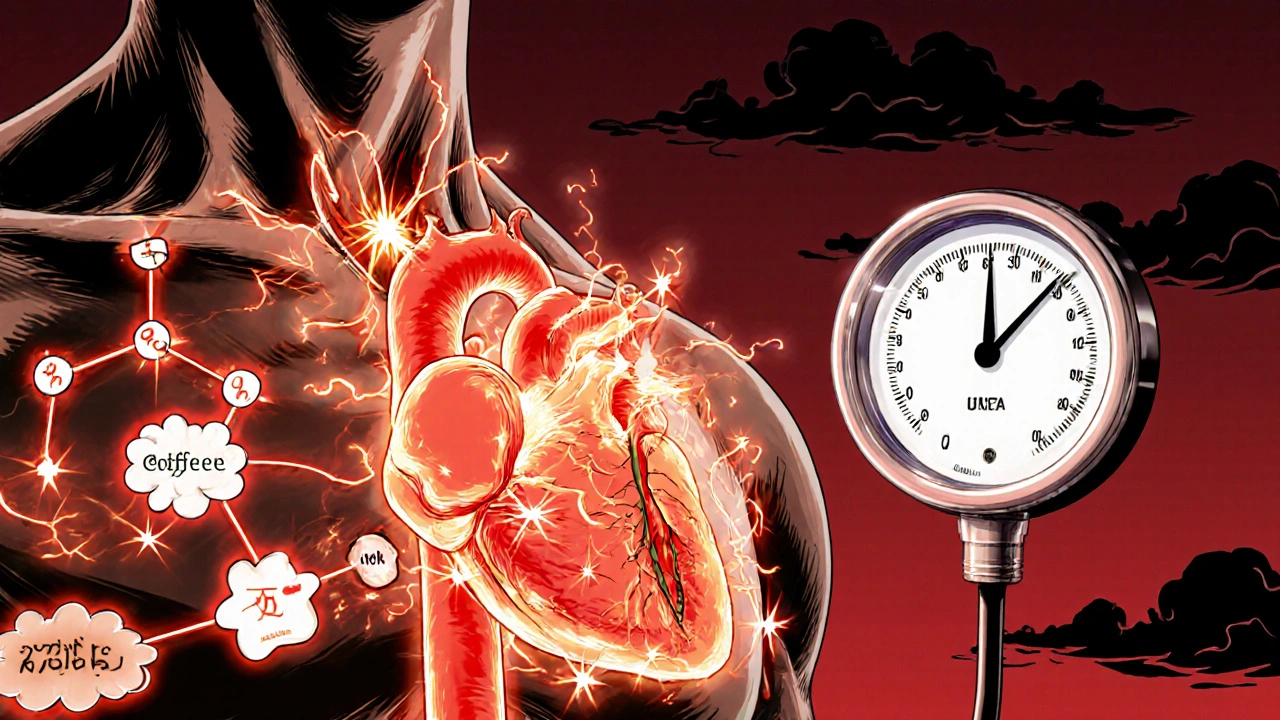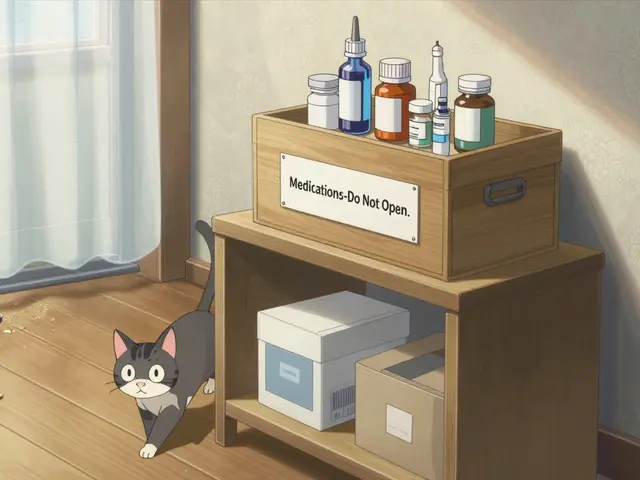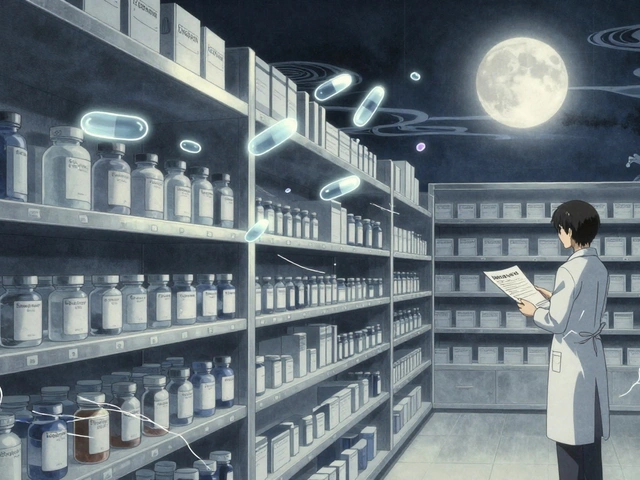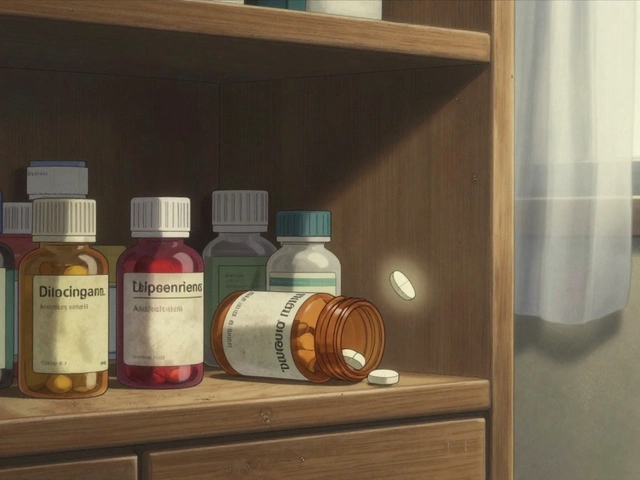Blood Pressure Risk Calculator
Calculate Your Combined Stimulant Risk
Enter your energy drink consumption and stimulant medication details to estimate potential blood pressure increase and risk level.
Your Estimated Risk
Total Caffeine:
0 mg
Estimated Blood Pressure Increase:
0 mmHg
Risk Level:
Low
Energy Drinks are beverages packed with high levels of caffeine a central nervous system stimulant that can raise heart rate and blood pressure, often mixed with other compounds like guarana, taurine, and bitter orange. At the same time, many people take Stimulant Medications prescription drugs such as amphetamine‑based Adderall or methylphenidate‑based Ritalin used mainly for ADHD. When the two are combined, the heart can get a double jolt, leading to spikes in blood pressure and rhythm disturbances. This article breaks down what the science says, why the risk matters, and how you can stay safe.
Key Takeaways
- One 240 mg caffeine energy drink can raise systolic blood pressure by up to 6 mmHg within half an hour.
- Prescription stimulants add 2-7 mmHg to systolic pressure and increase heart rate by 3-13 beats per minute.
- Combining the two can boost the blood‑pressure surge by 3‑5 times, especially in people with hypertension or heart disease.
- The FDA deems 400 mg caffeine per day safe for most adults, but teens should stay under 100 mg.
- Warning signs - chest pain, severe headache, palpitations, or shortness of breath - demand immediate medical attention.
Why Energy Drinks Spike Blood Pressure
Energy drinks deliver caffeine in a quick‑absorbing liquid form, which hits the bloodstream faster than coffee. The Mayo Clinic study (2015) showed a 6.2 % rise in average blood pressure after a single 240 mg caffeine drink. Caffeine triggers the adrenal glands to release adrenaline, a hormone that narrows blood vessels and pushes the heart to pump harder. A Harvard Health analysis (2023) quantified this rise in adrenaline at 74.8 %.
But caffeine isn’t acting alone. Guarana adds another 3.6-5.8 % caffeine by weight, and bitter orange brings synephrine, a compound that mimics ephedrine’s effect on the cardiovascular system. Together they create a synergistic boost that can push systolic pressure up by 15 mmHg in susceptible individuals within 30 minutes.
How Stimulant Medications Influence the Heart
Amphetamine the active ingredient in Adderall, works by increasing dopamine and norepinephrine levels in the brain raises heart rate by 3‑13 beats per minute and adds 2‑7 mmHg to systolic pressure, according to FDA labeling (2023). Methylphenidate found in Ritalin and Concerta, operates similarly but with a slightly milder cardiovascular profile. Both drug classes force the heart to beat stronger, a mechanism that becomes risky when another stimulant is already on board.
Clinical observations reveal that patients taking these meds often experience a baseline increase of 4‑6 mmHg in systolic pressure. While the rise seems modest, it matters because the heart is already working harder, leaving less margin for any additional stress.
When the Two Meet: The Dangerous Synergy
Studies that pooled data from energy‑drink users on stimulant meds found a three‑to‑five‑fold increase in acute cardiovascular events compared to taking either substance alone. The NIH‑funded trial (NCT04822311) reported that combined use doubled the odds of arrhythmia and tripled the risk of hypertensive crises in adults aged 18‑35.
Real‑world cases illustrate the point. A 19‑year‑old with ADHD experienced a heart attack after drinking three 16‑oz Monster Energy cans (≈160 mg caffeine each) within two hours while on Adderall. Emergency rooms see similar patterns: blood‑pressure spikes from 120/80 to 150/95 in less than an hour, accompanied by palpitations and dizziness.

Comparing Caffeine Content and Dosage
| Product / Medication | Caffeine (mg) per serving | Typical Dose | Average BP Increase* |
|---|---|---|---|
| Red Bull (8.4 oz) | 80 | 1 can | ≈4 mmHg |
| Monster Energy (16 oz) | 160 | 1 can | ≈6 mmHg |
| Bang Energy (16 oz) | 300 | 1 can | ≈9 mmHg |
| Adderall (mixed amphetamine salts) | ≈5‑30 mg (equiv. caffeine effect) | 5‑30 mg per dose | 2‑7 mmHg |
| Methylphenidate (Ritalin) | ≈5‑60 mg (equiv. caffeine effect) | 5‑60 mg per dose | 2‑5 mmHg |
*Values represent average acute increases observed in controlled studies; individual responses vary.
Who Is Most at Risk?
Hypertension chronically elevated blood pressure, a major risk factor for heart attack and stroke patients are especially vulnerable. The American Heart Association’s 2024 statement advises complete avoidance of energy drinks for anyone diagnosed with hypertension or coronary artery disease.
Young adults without known heart disease can still be caught off guard. A 2017 study (PMC5714807) recorded 20‑30 mmHg spikes in a subset of healthy college students after a single high‑caffeine drink. The spike lasted up to two hours, enough to trigger arrhythmias in predisposed individuals.
Adolescents are another red flag. The American Academy of Pediatrics recommends zero energy‑drink consumption for teens, citing a 24.2 % rise in pediatric exposures from 2022‑2023. Even a “diet” or “sugar‑free” version contains the same stimulant load.
Recognizing Warning Signs
If you notice any of the following after drinking an energy beverage or taking a stimulant med, seek care right away:
- Chest pain or tightness
- Severe headache or visual disturbances
- Palpitations lasting more than a few minutes
- Sudden shortness of breath
- Extreme dizziness or fainting
These symptoms often signal an acute hypertensive episode or an arrhythmia, both of which can become life‑threatening if untreated.

Practical Tips for Safer Consumption
- Know your baseline: measure blood pressure before you start any new energy‑drink habit.
- Limit caffeine to ≤400 mg per day for adults; ≤100 mg for teens.
- Avoid mixing energy drinks with prescription stimulants, alcohol, or intense exercise.
- Read labels carefully - some “energy shots” contain up to 200 mg caffeine in a 2‑oz bottle.
- If you already take a stimulant medication, skip energy drinks entirely.
- Gradually taper off if you’re a daily consumer; abrupt stops can cause withdrawal headaches and fatigue for up to 9 days.
- Stay hydrated and balance with foods low in sodium to help blood‑pressure regulation.
For anyone with a known heart condition, the safest rule is: energy drinks are a no‑go.
What the Regulators Are Doing
The FDA still classifies caffeine as “Generally Recognized as Safe” under 400 mg daily, but it has started issuing warning letters to manufacturers whose products vastly exceed label claims. In Europe, the EFSA caps a single dose at 200 mg and mandates clear warning labels above that level. Canada requires a mandatory label for drinks over 180 mg caffeine. In the U.S., lawsuits are rising - more than 147 cases from 2018‑2023 allege inadequate warnings.
Despite regulation, sales keep climbing. Statista reported $77.6 billion in global energy‑drink revenue in 2023, with a projected 12 % CAGR through 2028. The market’s growth underscores why clinicians and consumers must stay informed.
Frequently Asked Questions
Can I safely drink an energy drink if I take ADHD medication?
No. Combining the two creates a synergistic stimulant effect that can triple the risk of a hypertensive crisis or arrhythmia. The safest choice is to avoid energy drinks altogether while on prescription stimulants.
How much caffeine is too much for a healthy adult?
The FDA’s guideline is 400 mg per day, roughly four 8‑oz cups of coffee or two high‑caffeine energy drinks. Consuming more can lead to noticeable blood‑pressure spikes.
Do sugar‑free energy drinks pose the same heart risk?
Yes. Sugar content doesn’t affect the stimulant load. Sugar‑free versions often contain equal or higher caffeine levels, so the cardiovascular impact is the same.
What are the early signs of a caffeine‑induced blood‑pressure spike?
Rapid heartbeat, jitteriness, headache, and a sense of “full‑body” pressure are common early clues. If they persist beyond 30 minutes, check your blood pressure.
Can regular energy‑drink use lead to long‑term heart disease?
Emerging research (UC Davis, 2024) links chronic consumption to endothelial dysfunction, a precursor to atherosclerosis. While causality isn’t fully proven, the trend suggests a possible long‑term risk.
Staying informed is the first line of defense. By understanding how caffeine, guarana, amphetamines, and methylphenidate each stress the cardiovascular system, you can make smarter choices that protect your heart.









ahmed ali
October 26, 2025 AT 17:40The article nails the basic pharmacology but skims over the metabolic nuances that actually drive the cardiovascular spikes. For instance, the hepatic enzyme CYP1A2, which processes caffein, varies wildly among individuals due to genetics and lifestyle. People with the *slow* metabolizer allele can experience prolonged caffein half‑life, turning a single energy drink into a multi‑hour stimulant bath. Add to that teh fact that guarana’s caffein is bound to chlorogenic acids, which delays absorption rather than accelerating it. This delayed release means the blood pressure rise can be biphasic, with an initial bump from caffein followed by a secondary surge as guarana kicks in. On the prescription side, amphetamine‑based meds like Adderall also induce CYP2D6 inhibition, which can back‑up the clearance of other catecholamines. The synergistic effect is therefore not just a simple additive 5‑mmHg; it can be a compounded 12‑15‑mmHg for those with overlapping metabolic bottlenecks. The article mentions “synergy” but fails to clarify that the synergy is mediated by the autonomic nervous system’s baroreflex resetting. When baroreceptors are repeatedly stressed, they lose sensitivity, making each subsequent stimulant episode more dangerous. In a real‑world scenario, a college student who drinks two cans of Monster while on 20 mg of Adderall may not feel jittery, but their systolic pressure could secretly balloon from 118 to 138 within 45 minutes. That hidden rise is often why arrhythmias go unnoticed until an ECG is done for an unrelated reason. Moreover, the article overlooks the role of electrolyte shifts-especially potassium loss from diuretic‑like caffein effects-that can predispose to ventricular ectopy. The interplay between potassium depletion and increased catecholamine tone is a perfect storm for torsades de pointes. It’s also worth noting that the “safe” 400 mg caffein limit assumes a healthy cardiovascular baseline; patients with subclinical hypertension already start above optimal ranges. Therefore, the guideline should be personalized, factoring in genetic metabolizer status, existing meds, and even sleep debt, because sleep deprivation itself raises sympathetic tone. Bottom line: don’t just count milligrams, consider the whole physiological context before mixing energy drinks with ADHD meds.
Deanna Williamson
October 27, 2025 AT 21:27The data you cite is solid, yet the piece skirts the methodological limitations of the cited studies. Many of the referenced trials used small, homogenous cohorts that don’t reflect the broader ADHD population. Additionally, the lack of long‑term follow‑up leaves open the question of chronic vascular remodeling. In practice, clinicians should weigh these gaps before issuing blanket warnings.
Chris L
October 29, 2025 AT 01:14I totally agree with the emphasis on baseline blood pressure checks. Knowing your numbers before you start any new habit is a simple yet powerful preventive step. For folks already on stimulants, skipping energy drinks entirely removes a major variable. Let’s keep spreading this practical advice.
Charlene Gabriel
October 30, 2025 AT 05:00You’ve hit the nail on the head with the baseline check suggestion, and I’d like to expand on why that matters beyond a single reading.
A resting measurement taken after a night of adequate sleep gives a clearer picture of true cardiovascular tone.
If you notice a consistent upward drift over a week, that may signal that even modest caffeine intake is nudging your system in the wrong direction.
In such cases, gradual tapering of both prescription stimulants and any ancillary caffeine sources can reset the baroreflex sensitivity.
Coupling this with a low‑sodium diet and regular aerobic activity has been shown to blunt sympathetic spikes.
I’ve seen patients who replaced a daily energy shot with a green tea and reported steadier heart rates within days.
Remember, the goal isn’t abstinence for everyone, but informed moderation tailored to individual risk profiles.
Keep the conversation going; the more we share nuanced strategies, the safer the community becomes.
Leah Ackerson
October 31, 2025 AT 08:47In the grand theatre of the body, each stimulant plays its role like a restless actor on a cramped stage 🌌. Energy drinks are the flash‑bulb lighting that momentarily dazzles, while prescription meds are the script that drives the plot forward 📜. When both spotlight the same scene, the audience-our heart-can feel the overload and demand an intermission. One might argue that the pursuit of heightened performance is a modern echo of ancient hubris, a reminder that the mortal coil resists limitless acceleration 🚀. Yet, the wisdom hidden in the article nudges us toward humility, urging a respectful pause before we chase the next surge. 🙏
Gary Campbell
November 1, 2025 AT 12:34What the mainstream media won’t tell you is that the energy‑drink boom is being orchestrated by a coalition of big pharma and caffeine cartels. They fund the studies that set the “400 mg safe” threshold, ensuring the public stays complacent while profits soar. The FDA’s so‑called “warning letters” are just a façade to placate watchdogs, not a genuine attempt at regulation. If you dig into the lobbying disclosures, you’ll see companies behind major ADHD meds also hold stakes in leading beverage conglomerates. So the “risk” narrative is deliberately muted to keep the consumer base hooked on two synergistic products.
renee granados
November 2, 2025 AT 16:20That’s a wild claim, but the data still shows mixing them raises blood pressure regardless of hidden agendas.
Stephen Lenzovich
November 3, 2025 AT 20:07As an American who values freedom, I’m proud that our market offers choices, yet we must also champion responsible consumption. Our competitors abroad may impose stricter limits, but we lead by example when we educate our citizens. The ingenuity behind these drinks is undeniable, but let’s not forget that true strength comes from discipline, not from chasing a caffeine high. In the end, a nation’s health is its greatest asset.
abidemi adekitan
November 4, 2025 AT 23:54Indeed, the tapestry of our culture weaves both innovation and self‑care. Imagine a bustling Lagos street where a vendor offers a modest, herbal‑infused brew-fresh, vibrant, and mindful of the heart. If we channel that same creative spirit into our energy‑drink choices, we can celebrate vigor without compromising wellbeing. Let’s paint a future where flavor and health dance together in harmonious rhythm.
Barbara Ventura
November 6, 2025 AT 03:40Wow!!! So many facts!!!